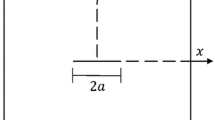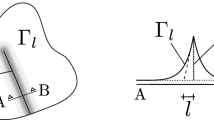Abstract
The paper presents a versatile and efficient technique, the weight function method, for calculating stress intensity factors for cracks in thermal stress fields. A unified analytical approach to the derivation of closed-form weight functions for various crack geometries is outlined. To facilitate engineering applications, analytical expressions of stress intensity factors for several basic crack face load cases, including power stress distributions and a linear-varying stress segment are presented. These results, when coupled with the superposition principle, enable stress intensity factors under arbitrary loadings to be accurately determined with minimum effort. To illustrate the approach, the weight function method is used to solve a variety of two- and three-dimensional thermal crack problems. Particular attention is given to verify the accuracy of the derived weight functions and stress intensity factors, by checking with those in the literature obtained with other methods. The unique efficiency and simplicity of the weight function method in analyzing thermal crack problems, especially for parametric studies, are demonstrated.
Access this chapter
Tax calculation will be finalised at checkout
Purchases are for personal use only
Preview
Unable to display preview. Download preview PDF.
Similar content being viewed by others
References
Nied, H.F. (1983) ‘Thermal shock fracture in an edge-cracked plate’, J. Thermal Stresses 6, 217–229.
Sato, S., Awaji, H. and Akuzawa, H. (1978) ‘Evaluation of the thermal shock fracture toughness of reactor graphites by arc discharge heating’, Carbon 16, 103–109.
Emery, A.F., Walker, G.E., Jr and Williams, J.A. (1969) ‘A Green’s function for the stress-intensity factors of edge cracks and its application to thermal stresses’, Trans ASME, J. Basic Engng. 91, 618–624.
Hellen, T.K., Cesari, F. and Maitan, A. (1982) ‘The application of fracture mechanics in thermally stressed structures’, Int. J. Pres. Ves. & Piping 10, 181–204.
Wu, X.R. (1987) ‘Stress intensity factors for circumferentially cracked hollow cylinder with thermal stresses’, in Proc. Int. Conf. on Fracture and Fracture Mechanics, Fudan University Press, Shanghai, China, pp. 638–642.
Bueckner, H.F. (1958) ‘The propagation of cracks and the energy of elastic deformation’, Trans ASME 80, 1225–1229.
Heaton, M.D. (1976) ‘On the calculation of stress intensity factors due to thermal and residual stress fields’, Report of Central Electricity Generating Board (U.K.), NW/SSD/RR/158/76.
Bueckner, H.F. (1970) ‘A novel principle for the computation of stress intensity factors’, Z. Angew. Math. Mech. 50, 529–545.
Rice, J.R. (1972) ‘Some remarks on elastic crack-tip stress fields’, Int. J. Solids Structures 8, 751–758.
Paris, P.C., McMeeking, R.M. and Tada, H. (1976) ‘The weight function method for determining stress intensity factors’, ASTM STP 601, 471–489.
Labbens, R., Pellissier-Tanon, A. and Heliot, J. (1976) ‘Practical method for calculating stress intensity factors through weight functions’, In Mechanics of Crack Growth, ASTM STP 590, 368–384.
Wu, X.R. and Carlsson, J. (1983) ‘The generalized weight functions method for crack problems with mixed boundary conditions’, J. Mech. Phys. Solids 31, 485–497.
Wu, X.R. (1984) ‘Approximate weight functions for center and edge cracks’, Engng Fract. Mech. 21, 35–49.
Wu, X.R. and Chen, X.G. (1990) ‘Wide-Range weight function for center cracks’, Engng Fract. Mech. 33, 877–886.
Wu, X.R. (1992) ‘Analytical wide-Range weight functions for various finite cracked bodies’, Engng Analysis with Boundary Elements, Vol. 9.
Wu, X.R. and Carlsson. A.J. (1991) Weight Functions and Stress Intensity Factor Solutions, Pergamon Press, Oxford.
Zhao, W., Wu, X.R. and Yan, M.G. (1989), ‘Weight function method for three dimensional crack problems’, Engng Fract. Mech. 34, 593–607 (Part I ), 609–624 (Part II).
Zhao, W. (1988) Weight Function Method for Three Dimensional Crack Analysis - Theory and Application, PhD thesis, Institute of Aeronautical Materials, Beijing, China.
Zhao, W. and Wu, X.R. (1990) ‘Stress intensity factors for corner cracks at a semi-circular notch under stress gradients’, Fatigue Fract. Engng Mater. Struct. 13, 347–360.
Zhao, W. and Wu, X.R. (1990) ‘Stress intensity factor evaluation by weight function for surface crack in edge notch’, Theoretical and Applied Fracture Mechanics 13, 225–238.
Cruse, T.A. and Besuner, P.M. (1975) ‘Residual life prediction for surface cracks in complex structural details’, J. Aircraft 12, 369–375.
Mattheck, C., Morawietz, P. and Munz, D. (1983) ‘Stress intensity factor at the surface and at the deepest point of a semi-elliptical surface crack in plates under stress gradients’, Int. J. Fract. 23, 201–212.
Xu, R.X. and Wu, X.R.-(1989) ‘A weight function approach to stress intensity factors for half-elliptical surface cracks in cylindrical pressure vessels subjected to thermal shock’, Int. J. Pres. Ves. & Piping 39, 375–391.
Hellen, T.K. and Cesari, F. (1979) ‘On the solution of the center cracked plate with a quadratic thermal gradient’, Engng Fract. Mech. 12, 469–478.
Wu, X.R. (1984) ‘Application of approximate weight functions in fracture analysis of thermally stressed structures’, Int. J. Pres. Ves. Si Piping 16, 53–66.
Tada, H., Paris, P.C. and Irwin, G.R. (1985), The Stress Analysis of Cracks Handbook ( 2nd edition ), Del Research Corporation, St. Louis, Missouri.
Young, W.C. (1989), Roark’s Formulas for Stress and Strain, McGraw-Hill Book Company, 6th edition.
Fett, T., Mattheck, C. and Munz, D. (1987) ‘On the calculation of crack opening displacement from the stress intensity factor’, Engng Fract. Mech. 27, 697–715.
Gregory, R.D. (1989) ‘The spinning circular disc with a radial edge crack; an exact solution’, Int. J. Fract. 41, 39–50.
Gregory, R.D. (1990.).Private communication.
Nied, H.F. and Erdogan, F. (1983) ‘Transient thermal stress problem for a circumferentially cracked hollow cylinder’, J. Thermal Stresses 6, 1–14.
McGowan, J.J. and Raymund, M. (1979) ‘Stress intensity factor solutions for internal l semi-elliptical surface flaws in a cylinder under arbitrary loadings’, longitudinal STM STP 677, 365–380.
Raju, R.S. and Newman, J.C., Jr. (1982) ‘Stress intensity factor influence coefficients for internal and external surface cracks in cylindrical vessels’, in Aspects of Fracture Mechanics in Pressure Vessels and Piping 58, 37–48.
Jaeger, J.C. (1945) ‘On thermal stress in circular cylinders’, Philosophical Magazine 36, 418–428.
Oliveira, R. and Wu, X.R. (1987), Stress intensity factors for axial cracks in hollow cylinders subjected to thermal shock, Engng Fract. Mech. 27, 185–197.
Author information
Authors and Affiliations
Editor information
Editors and Affiliations
Rights and permissions
Copyright information
© 1993 Springer Science+Business Media Dordrecht
About this chapter
Cite this chapter
Wu, X.R. (1993). Application of Weight Function Method for Crack Analysis in Thermal Stress Fields. In: Schneider, G.A., Petzow, G. (eds) Thermal Shock and Thermal Fatigue Behavior of Advanced Ceramics. NATO ASI Series, vol 241. Springer, Dordrecht. https://doi.org/10.1007/978-94-015-8200-1_10
Download citation
DOI: https://doi.org/10.1007/978-94-015-8200-1_10
Publisher Name: Springer, Dordrecht
Print ISBN: 978-90-481-4291-0
Online ISBN: 978-94-015-8200-1
eBook Packages: Springer Book Archive




